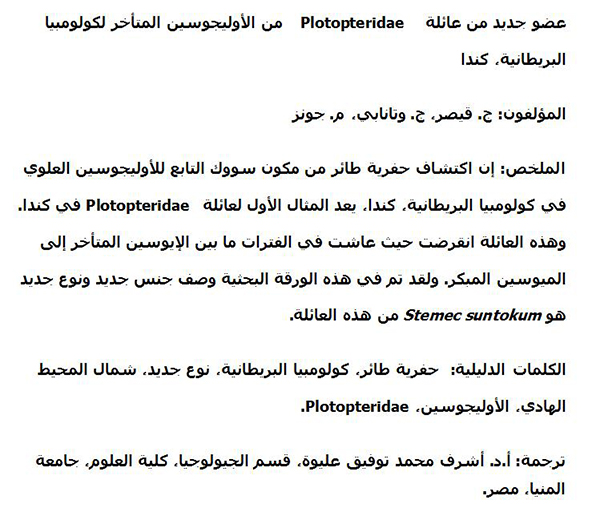A new member of the family Plotopteridae (Aves) from the late Oligocene of British Columbia, Canada
Plain Language Abstract
The Oligocene sandstones of the Sooke Formation, at the southern end of Vancouver Island, British Columbia, are rich in mammal fossils from 24 million years ago, but bird fossils are scarce. One was found in the 1890s but no more appeared until three bones were given to the Royal BC Museum at the end of 2013. Two were incomplete leg bones that were not very informative but the third was a complete and well-preserved coracoid. In birds, the coracoid lies in the shoulder at the focus of forces generated by forelimb-powered locomotion. The forces shape the articulating surfaces for the scapula, furcula, and humerus into distinctive features. In contrast, the shaft of the coracoid is usually simple, ending in a wide flange that distributes stress to the breastbone.
The head of the Sooke coracoid included a set of features that identified its owner as a small member of the Plotopteridae, an extinct family of wing-propelled diving birds that lived in the North Pacific Ocean between 16 and 35 million years ago. The shaft of the new fossil is exceptionally long and slender, as in other plotopterids. It does not end in a wide flange.
The biggest difference between this new fossil and other plotopterids is size. Most plotopterids were giants, reaching 2m in length. The new fossil suggests a bird about the size of a small cormorant. Plotopterum joaquinensis, the first species to be discovered, is the only one known to have a similar size.
The details of structures on the head of the Sooke fossil differ from Plotopterum joaquinensis and we named the new find Stemec suntokum. The genus name means long-necked duck in the language of the first nation's people from Sooke and the species name recognizes the work of Leah and Graham Suntok who found the fossil.
Resumen en Español
Un nuevo miembro de la familia Plotopteridae (Aves) del Oligoceno tardío de la Columbia Británica, Canadá
El descubrimiento de un fósil de ave, en rocas del Oligoceno superior de la Formación Sooke en el suroeste de la Isla de Vancouver, Columbia Británica, constituye el primer ejemplo para Canadá de Plotopteridae, una familia extinta que vivió en el Pacífico Norte desde finales del Eoceno al Mioceno temprano. El fósil es un coracoides bien conservado y prácticamente completo que exhibe las características diagnósticas de la familia. Se describe Stemec suntokum como un nuevo género y especie para esta extinta familia de aves con buceo propulsado por las alas. Los coracoides son huesos excepcionalmente informativos que se encuentran en el foco de las fuerzas que actúan sobre el hombro y donde juegan un papel importante en la biomecánica de la locomoción de las aves. El coracoides de Stemec tiene un eje inusualmente estrecho, cónico, que difiere fundamentalmente de los coracoides aplastados y anchos de otros grupos de aves.
Palabras clave: fósiles de aves; Columbia Británica; Nuevas especies; Pacífico Norte; Oligoceno; Plotopteridae
Traducción: Enrique Peñalver
Résumé en Français
Un nouveau représentant de la famille Plotopteridae (Aves) de l'Oligocène récent de Colombie-Britannique, Canada
Un fossile d'oiseau découvert dans l'Oligocène supérieur des roches de la formation de Sooke au sud-ouest de l'île de Vancouver, Colombie-Britannique, est le premier représentant canadien des Plotopteridae, une famille disparue qui vivait dans le Pacifique Nord de l'Éocène récent au Miocène ancien. Le fossile est un coracoïde quasi-complet et bien préservé, montrant les caractères diagnostiques de cette famille. Stemec suntokum est décrit comme un nouveau genre et une nouvelle espèce de cette famille disparue d'oiseaux plongeurs utilisant leurs ailes pour se propulser sous l'eau. Les coracoïdes sont des os exceptionnellement informatifs, situés au point de rencontre des forces agissant sur l'épaule où ils jouent un rôle majeur dans la biomécanique de la locomotion des oiseaux. Le coracoïde de Stemec présente une diaphyse inhabituellement étroite et conique, différant de manière fondamentale des coracoïdes larges et aplatis des autres groupes d'oiseaux.
Mots-clés : fossiles d'oiseaux ; Colombie-Britannique ; nouvelle espèce ; Pacifique Nord ; Oligocène ; Plotopteridae
Translator: Antoine Souron
Deutsche Zusammenfassung
Ein neues Mitglied der Familie Plotopteridae (Aves) aus dem späten Oligozän von British Columbia, Kanada
Der Fund eines Vogelfossils in der oberoligozänen Sooke Formation des südwestlichen Vancouver Island, British Columbia ist der erste Nachweis der Plotopteridae, einer ausgestorbenen Familie, die vom späten Eozän bis ins frühe Miozän im Nordpazifik lebte. Das Fossil ist ein nahezu komplettes, gut erhaltenes Coracoid, das die diagnostischen Merkmale der Familie aufweist. Stemec suntokum wird als neue Gattung und Art dieser Familie ausgestorbener Tauchvögel beschrieben, die mit ihren kurzen Flügeln Vortrieb generierten. Coracoide sind äußerst aussagekräftige Knochen die am Mittelpunkt der Kräfte liegen, die auf die Schulter wirken und die an dieser Stelle eine wichtige Rolle in der Biomechanik der Vogel-Lokomotion spielen. Das Coracoid von Stemec hat einen ungewöhnlich schmalen, konischen Schaft der sich grundlegend von den breiten, flachen Coracoiden anderer Vogelgruppen unterscheidet.
Schlüsselwörter: Vogelfossil; British Columbia; neue Art; Nordpazifik; Oligozän; Plotopteridae
Translator: Eva Gebauer
Arabic

Translator: Ashraf M.T. Elewa

